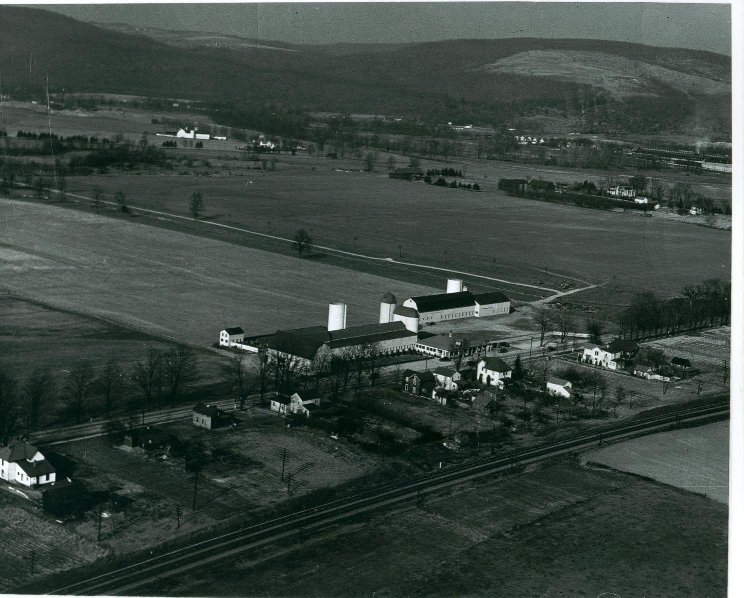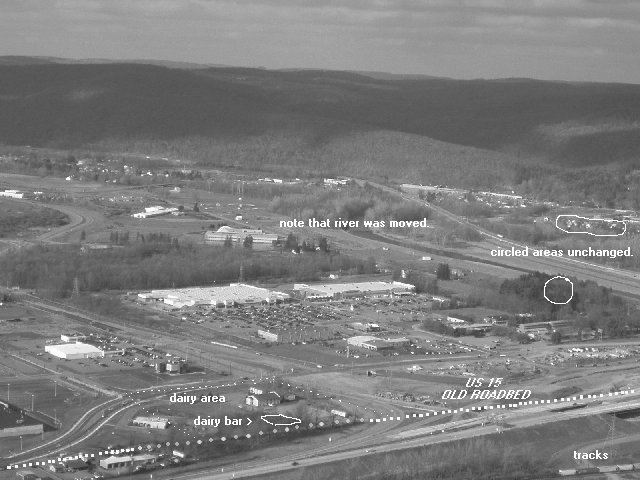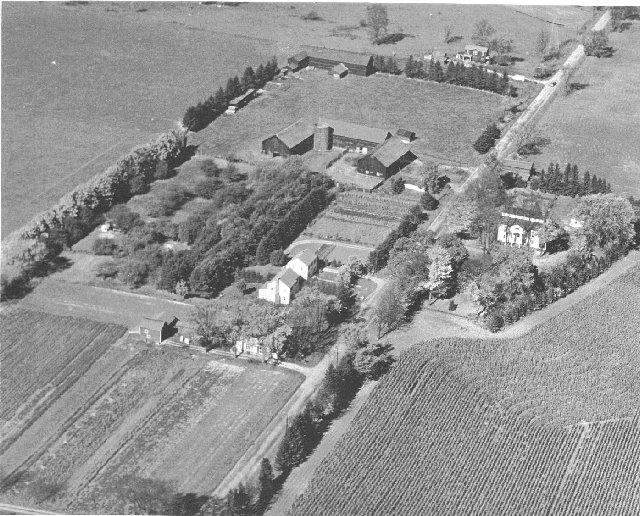
CHANGES IN THE AREA OF DANN'S DAIRYGONE TO HELL IN A HANDBASKET
1935 TO 2006
Some pepole think that progress is great. I guess that if I felt that way, I wouldn't spend so much time foolin' with things that are long gone. The following pictures and text are self- explanatory. The first picture was taken about 1935.

I took this picture in November 2006, trying my best to duplicate the direction and angle of the original. It is not easy to do while flying below the ridge-tops in the middle of the day while fiddling with a camera. The original was taken through the larger lens of a professional camera, and operated by a photographer, not a pilot.

DISCUSSION
In the picture above, note the lay of the old road (US 15) past the dairy. I remember as a child, leaving Painted Post towards the dairy and crossing the steel truss bridge immediately at the edge of town. A concrete levee ran along the village, separating it from the river that ran past its doorstep. You passed from the village, through a break in the levee, and onto the bridge.
Once over the bridge, there was a small electric sub-station to the right, and then you passed along a half- mile of cornfield. Canada Road intersected the highway to the right, leading to Bob and Helen's house, several of Bob's barns and the Scudder Dairy.
Continuing west on the highway though, there was about three quarters of a mile of pasture before reaching the dairy plant and the main barns.
The 2006 picture has a little bit of the rail line at the bottom corner; this can help orient you to the older picture. The dairy location is outlined with dots, just like the old roadbed. In comparing the two pictures, the one thing that I find to be the most astounding is that all the buildings that you can see in the 1930s picture are gone in 2006... except for the old Erwin house that where Bob ans Helen lived, now hidden in pine trees, and the Ingersoll- Rand company houses noted in the distance.
I don't know how much of a surprise all the development was to Bob. He knew that the area would grow, mostly because of Corning Glass, and that was part of the reason that he settled there. Still, I think that it was a surprise to him that the first round of development in the area took almost a hundred acres of prime corn ground, and put a road through the dairy barn complex.
He went on to build the motel, fancy houses on the hillside, and the Spring Pond Apartments, all on farm land which had developed a commercial value. He enjoyed the challenge of putting all of these things together, but I have always thought that he would have preferred to remain in 1959.
Once, in the late 1970s, I asked him to name his favorite year... The year that in his mind, all things in life were the best. I thought that he would give some year in the mid- fifties, but after just a moment's thought, he said "1914". He added that 1914 was the year that the house burned and that he "went to work" leaving school behind.
He said that was the year when he felt that there was the most opportunity and the least amount of restriction upon the enterprise of business. I concluded for him that "things have gone downhill since then" and he nodded.
Looking back, it probably isn't surprising that a brand- new adult should feel flushed with opportunity and not be dulled by the constraints of life. I would answer the same question the same way. I have always had an appreciation for simpler things.
Looking at the pictures above, and below, it is plain that things are no longer simple. The world is different, and the Erwin Valley has been a part of that change.


These pictures show Bob and Helen's home and the barns around it, the former Sebring Farm. The old picture shows nothing but house and barns. The river is half a mile away, running along the edge of the village.
The barns are long gone, and the Lodge on the Green is at the lower left and Home Depot is visible in the upper left. I can remember standing in the farmyard and seeing nothing but pasture, corn, or alfalfa all the way to the dairy farm. Now there is an auto dealership, the motel, Wal- Mart, and Home Depot fill the view. It is ironic that the dairy buildings were once the only buildings in the view, and now the only empty land is where the dairy was.